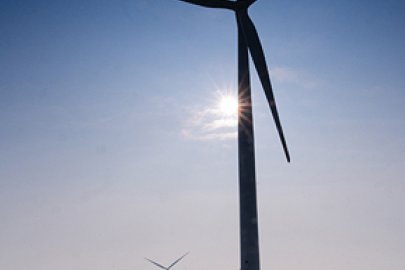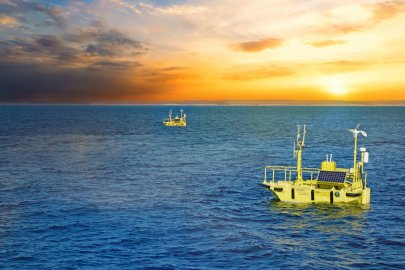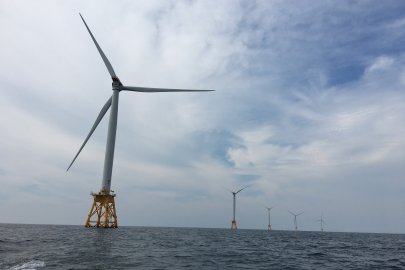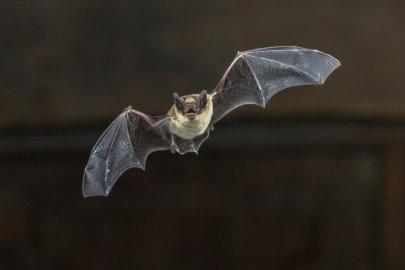Natural Power has developed the first-ever smart curtailment technology that simultaneously reduces bat fatalities and energy losses at wind farms.
Wind Energy Technologies Office
June 2, 2021Natural Power’s DARC system recovers energy that would be lost under a blanket-curtailment strategy
One of the most effective ways to reduce bat fatalities around wind power plants is to restrict, or “curtail,” wind turbine operations during periods of high risk to bats, such as the fall migratory season. However, this blanket-curtailment approach can cause large, unnecessary energy losses because it is implemented even when bats are not present. Energy losses under blanket curtailment are typically around 2% of annual energy production but can be as high as 8%. Lower annual energy production means less power available and lower economic return from the wind power plant.
Natural Power’s Detection and Active Response Curtailment (DARC™) system aims to reduce wind energy’s impact on bats while increasing energy production when compared to blanket curtailment. The Wind Energy Technologies Office (WETO) awarded funding to Natural Power to validate the DARC system at an operational wind farm, increase cybersecurity, and assess how the system mechanically impacts wind turbines to address potential issues that might affect turbine warranties and overall longevity. The project is part of the Department of Energy's (DOE’s) ongoing support of technologies to reduce wind-wildlife interactions.
DARC comprises a complex system of hardware and software that includes data on bat biology, wind energy production and economics, wind turbine warranty and mechanical loads, grid cybersecurity, and permitting.
DARC is designed to curtail wind operations only when bats are present within the swept area of the turbine blades. Additional factors, such as wind speed and minimum temperature, can also influence DARC’s automated curtailment decisions established by a predetermined set of rules. When DARC detects bat activity, the system automatically curtails turbines for an initial 30 minutes through a process called “pitching out.”
“To implement curtailment, DARC signals turbines to pitch the blades out, or rotate the blades so they no longer catch incoming wind,” said Natural Power’s Commercial Manager of Wildlife Technology Kevin Denman. “The turbine blades are also slowed so that bats can more readily detect and avoid them, resulting in significantly fewer bat fatalities.”

This graphic shows how Natural Power’s Detection and Active Response Curtailment (DARC) system curtails wind turbine operation when bats are detected within the swept area of the turbine blades. Graphic by Natural Power
Using microphones mounted on select wind turbine nacelles, DARC continuously checks for bats’ ultrasonic echolocation calls (or sounds reflected off obstacles) and extends the shutdown period in 10-minute increments for as long as the bats are detected. By limiting curtailment to only those times when bats are present, DARC recovers energy that is lost under a blanket-curtailment strategy.
“With the addition of DARC, wind plants that are already operating have a more power-generation-friendly option for addressing bat fatalities,” said Denman. “Proposed wind farms that are concerned about the economic impacts of blanket curtailment or the ecological consequences of high-fatality rates—or both—now have a solution that might make such sites viable for development.”
To ensure robust cybersecurity and system performance, Natural Power used hardware with proven reliability, software that allows for site-specific modifications, and features that comply with North American Electric Reliability Corporation Critical Infrastructure Protection standards. Natural Power is also collaborating with National Renewable Energy Laboratory on cybersecurity and mechanical impacts studies.
Natural Power conducted the WETO-funded validation study in 2020 at Alliant Energy’s 170-megawatts English Farms wind power plant in Iowa under an endangered species research permit from the U.S. Fish and Wildlife Service (USFWS). The study compared bat fatalities and energy production at 69 wind turbines under three scenarios:
- Minimal curtailment, where the blades were pitched when wind speeds were below 3 meters per second (m/s)
- Blanket curtailment, where blades were pitched when wind speeds were below 6.9 m/s (as dictated by the USFWS-issued Technical Assistance Letter)
- DARC curtailment, where the blades were pitched only when wind speeds were below 6.9 m/s and when bats were present.
Published results from the WETO-funded research project are still pending, but initial data analysis suggests DARC can increase power production and achieve similar bat fatality reduction potential compared to blanket curtailment.
The first commercial DARC system was installed in May 2021 at a wind farm with federally protected bat species.
Subscribe to learn more about WETO R&D projects, news, accomplishments, and recent publications.
Subscribe to the WETO e-newsletter to stay informed on the latest wind energy news, events, publications, and updates.










